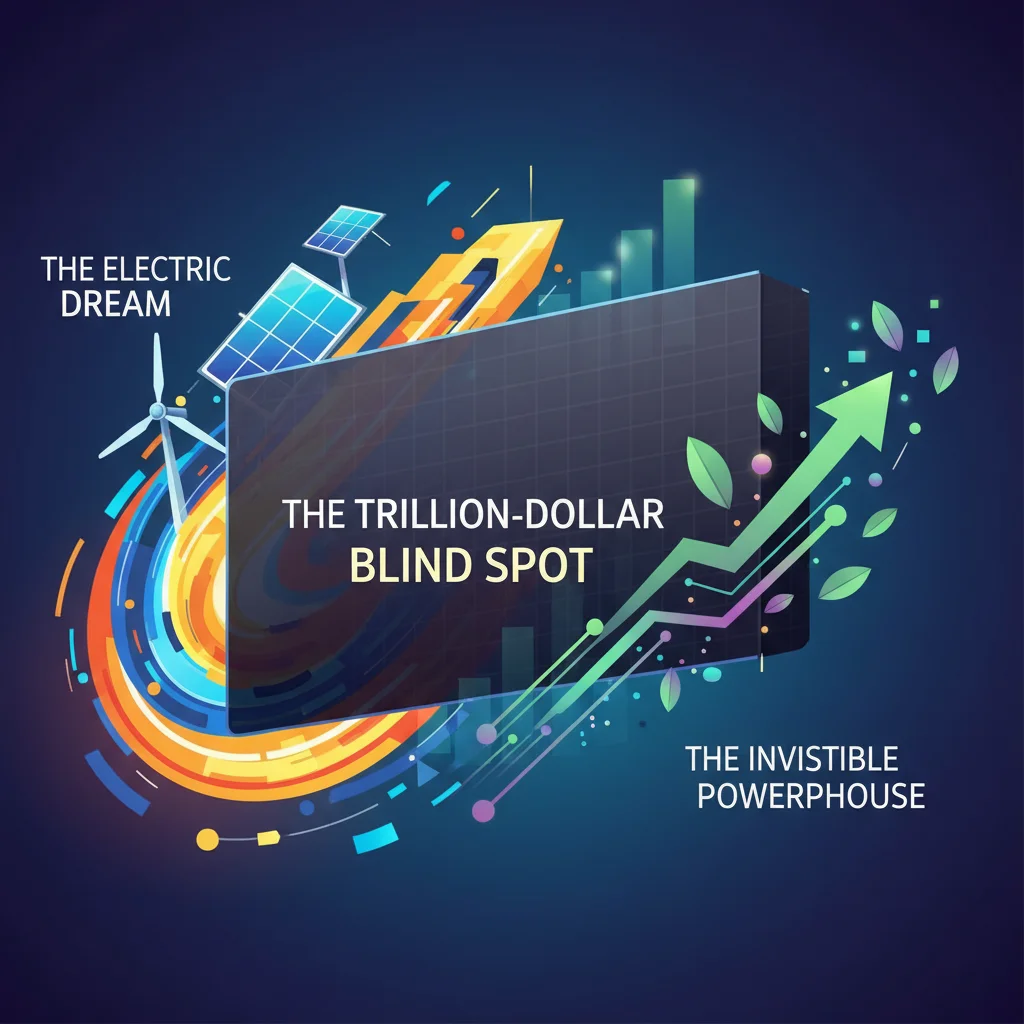
The Trillion-Dollar Blind Spot: Why Energy Efficiency is the Unsung Hero of Your Investment Portfolio
The Electric Dream vs. The Invisible Powerhouse
The global conversation around the energy transition is dominated by dazzling, high-tech solutions. We see images of sprawling solar farms, colossal offshore wind turbines, and sleek electric vehicles powered by revolutionary battery technology. The stock market buzzes with excitement, and venture capital pours billions into these sectors, chasing the next Tesla or CATL. This is the “sexy” side of decarbonization—a tangible, visible revolution in how we generate and store power. And while this focus is vital, it has created a monumental blind spot in our collective investment strategy, overlooking a solution that is cheaper, faster, and more impactful: energy efficiency.
In a concise but powerful letter to the Financial Times, Brandon Spencer, President of ABB Motion, highlighted a staggering fact: industrial electric motors alone consume 45% of the world’s electricity. The vast majority of these motors are inefficient, wasting enormous amounts of energy. This isn’t just an environmental issue; it’s a colossal economic drain and a misallocation of capital that should concern every investor, finance professional, and business leader. While we race to build new power sources, we are largely ignoring the low-hanging fruit of simply using less. This is the story of the trillion-dollar opportunity hiding in plain sight, an opportunity rooted not in generating more energy, but in wasting less.
The “First Fuel”: Redefining Energy Investment
The International Energy Agency (IEA) has long championed energy efficiency as the “first fuel.” The logic is simple and profound: the cheapest, cleanest, and most secure unit of energy is the one you don’t have to produce in the first place. Every kilowatt-hour saved through efficiency avoids the need for capital-intensive generation, complex transmission infrastructure, and the associated geopolitical risks tied to fuel supply chains. This has profound implications for the global economy and financial markets.
Consider the industrial heartland of the economy. A factory, a data center, or a water treatment plant runs on countless electric motors. A typical upgrade from an older, inefficient motor to a modern, high-efficiency model combined with a variable speed drive (VSD) can reduce that motor’s energy consumption by 25% or more. The payback period for such an investment is often remarkably short—typically less than two years. After that, the savings drop directly to the bottom line, boosting profitability, enhancing competitiveness, and increasing shareholder value for years to come.
Let’s compare the financial mechanics of investing in new generation versus efficiency. The following table illustrates the stark difference in approach and return on investment.
| Investment Metric | New Power Generation (e.g., Solar Farm) | Energy Efficiency Upgrade (e.g., Motor Retrofit) |
|---|---|---|
| Capital Outlay | Very High (Land, panels, inverters, grid connection) | Moderate to Low (New motors, drives, installation) |
| Payback Period | Long (Typically 7-15 years) | Short (Often under 2 years) |
| Operational Risk | Weather dependency, grid instability, component degradation | Minimal, often improves system reliability |
| Primary Return | Revenue from selling electricity | Operational cost savings (reduced electricity bills) |
| Impact on Energy Demand | Adds supply to the grid | Reduces demand from the grid, easing strain |
As the data shows, efficiency investments offer a faster, lower-risk path to both decarbonization and financial returns. For any company in the industrial or commercial sector, this isn’t an expense; it’s one of the highest-return investments available in today’s market. Ignoring it is a fundamental failure of financial management.
Truce on a Knife's Edge: Decoding the Economic Tremors of the Gaza Ceasefire for Global Investors
The Psychology of Capital: Why We Chase Glamour Over Guts
If the financial case is so compelling, why does energy efficiency receive a fraction of the investment and attention showered on renewables and EVs? The answer lies in a combination of human psychology, market structures, and outdated thinking in corporate finance.
Firstly, efficiency is invisible. A new solar farm is a powerful PR tool, a tangible symbol of a company’s commitment to sustainability. An upgraded motor inside a factory is not. It doesn’t make for a great press release or a compelling story for the stock market, even though its financial impact may be greater. This “visibility bias” heavily influences capital allocation in public and private markets.
Secondly, efficiency projects are often smaller and more distributed. It’s organizationally simpler for a large investment fund to write a single $500 million check for a new wind farm than to underwrite thousands of smaller $50,000 motor-upgrade projects across a portfolio of companies. This transactional friction has historically slowed the flow of capital. However, this is precisely where modern financial technology can bridge the gap. Fintech platforms are increasingly able to aggregate smaller projects, standardize underwriting, and create new financial instruments that make investing in distributed efficiency more accessible.
Finally, many corporate finance departments still classify efficiency upgrades as a maintenance cost rather than a strategic investment. They are often evaluated within short-term annual budgets, competing with other operational needs, rather than being assessed as a long-term, high-return capital investment that reduces systemic risk.
The Macroeconomic Case: Efficiency as an Economic Stabilizer
The benefits of a national focus on energy efficiency extend far beyond individual corporate balance sheets. It is a powerful tool for macroeconomic management and a cornerstone of a robust, modern economy.
By systematically reducing overall energy demand, a country can enhance its energy security, lessening its dependence on imported fossil fuels and the volatile global markets they trade on. This has a direct impact on taming inflation, as energy prices are a key component of the consumer price index. The IEA estimates that efficiency improvements implemented since 2000 are saving households in IEA countries USD 680 billion a year on their energy bills today.
Furthermore, this transition creates high-quality, local jobs in manufacturing, installation, and technology. Unlike a large, centralized power plant, efficiency retrofits happen in every town and city, stimulating local economies. The banking sector has a critical role to play by developing innovative financing products, such as green loans and efficiency-as-a-service models, to accelerate this deployment. We could even see the rise of new asset classes, where the verified energy savings from thousands of projects are securitized and traded, potentially using blockchain for transparent and immutable verification of results. This would transform energy savings from an abstract concept into a tangible financial instrument, unlocking a torrent of institutional investment.
The Peril of Prosperity: When Economic Blueprints Ignite Geopolitical Firestorms
An Actionable Roadmap for Investors and Leaders
Translating this understanding into action is the crucial next step. Both investors and corporate leaders need to fundamentally change how they view and value energy.
For Investors:
- Look beyond the obvious: When analyzing an industrial or manufacturing company, scrutinize its energy intensity. Does its annual report discuss investments in efficiency? A company actively reducing its energy consumption per unit of output is a company actively managing risk and improving margins.
- Invest in the enablers: Identify and invest in the companies that provide the core technologies for efficiency—firms like ABB, Schneider Electric, Siemens, and others that manufacture high-efficiency motors, drives, and control systems. They are the “picks and shovels” of this invisible gold rush.
- Demand better disclosure: Advocate for clearer corporate reporting on energy efficiency metrics as a core component of ESG (Environmental, Social, and Governance) analysis. According to a study by the U.S. Department of Energy, the potential for savings in the manufacturing sector alone is immense, and investors need data to price this potential.
For Business Leaders:
- Reframe the budget: Stop treating efficiency as a maintenance cost. Elevate it to a strategic capital investment to be evaluated by the CFO, not just the facility manager. The ROI is often higher and less risky than market expansion or M&A.
- Conduct a comprehensive audit: You cannot manage what you do not measure. A thorough energy audit of your operations will reveal numerous high-return opportunities that are currently invisible.
- Embrace new business models: Explore “efficiency-as-a-service” offerings, where a third-party provider installs and maintains the efficient equipment in exchange for a share of the savings. This eliminates the upfront capital expenditure, making it a cash-flow-positive decision from day one.
Beyond the Boardroom: Sweden's Blueprint for Investor Power in the Digital Age
Conclusion: The Smartest Watt is the One Never Used
The global energy transition is the most significant economic transformation of our time. While batteries and renewables are essential characters in this story, we have become so captivated by their narrative that we’ve forgotten the protagonist: energy efficiency. It is the bedrock upon which a sustainable and prosperous future must be built.
For investors, it represents a vast, undervalued market. For businesses, it is a direct path to higher profits and greater resilience. For the global economy, it is a powerful deflationary force that enhances security and drives sustainable growth. The time has come to shift our focus and our capital from a singular obsession with producing more to a balanced, intelligent strategy of using less. The most profitable trading, the wisest investment, and the most impactful economic policy begin with recognizing that the smartest kilowatt-hour is the one we never have to generate at all.


